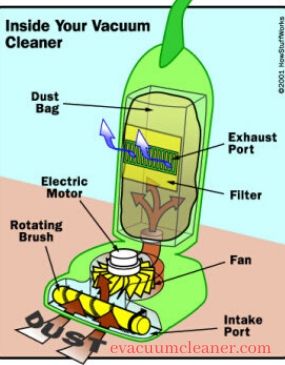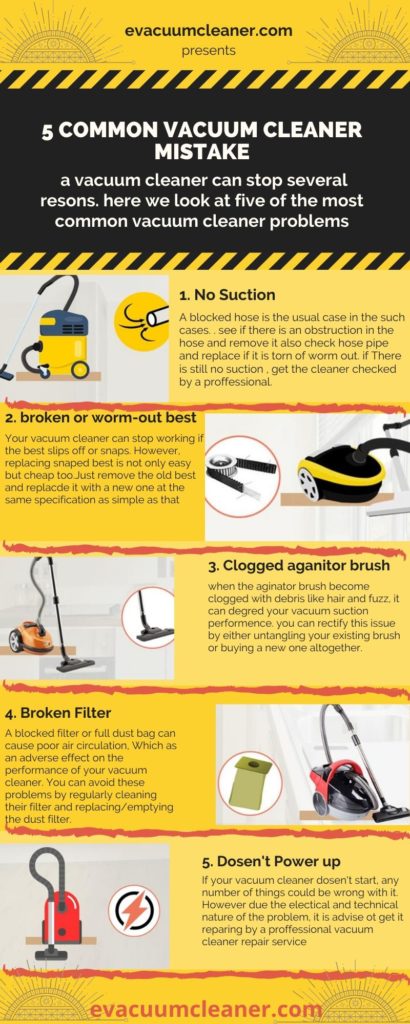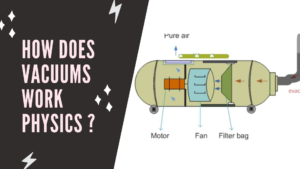In this era, dust and contamination are the major health threat to humankind. Because of the industrial revolution and also the revolution in the field of automobiles, our air always contains carbon particles as well as many other types of chemical contamination. So, to get a solution to this problem, we must think about a better technical cleaning device. And by then, a vacuum cleaner is introduced to humankind. Nowadays, it has become a ubiquitous device in almost every house. How does vacuums work physics is very interesting also? So, let’s get an overview of how does vacuums work in physics.
The physics behind the vacuum cleaner is elementary. We all know that a particle or object moves one place to another if there is any pressure difference. By any mean low-pressure zone can be created, the particle will move towards it. That’s the main physics main working principle of a vacuum cleaner. A vacuum cleaner has a centrifugal fan that is attached to its motor. The motor gets its power supply by electricity directly or by a battery source. The flow direction of the fan is set in the way that it blows air from the front part of the nozzle of the machine to the rear section. As a result, a suction force is created in the front nozzle area. By this suction force, dust particles are captured and get into the vacuum cleaner. The moving air molecules gather dust particles through suction & friction and carry them into the cleaner. Once inside, the air containing dust is made to pass through a dust bag that acts as a filter. It retains the debris and lets out clean air which is expelled through the outlet. That’s the main working procedure of a vacuum cleaner. The essential parts of the vacuum cleaner are –
- Intake port
- Exhaust port
- Centrifugal motor
- Fan
- Dust carrying bag
- Stand or handles

Motor, centrifugal fan, filter are three essential design items to make the improvement of the performance of the vacuum cleaner. Friction, noise, power consumption, suction pressure are the design variables that govern the aerodynamics and mechanical design factors. The nozzle and narrow compartment geometry play an essential role in maintaining the pressure and airflow pattern. This aspect is considered significant in the engineering development of the cleaning device. These are the most critical and essential parts of a vacuum cleaner and without all of these vacuum cleaner can’t be done.
If you want to know how all the procedure happens when you switch on your vacuum cleaner then there it is for you below –
- The electric current operates the motor part. The motor is connected to the fan, that has angled-blades (like a jet propeller)
- As the fan blades turn, they force air ahead, toward the exhaust port.
When air particles are driven forward, the density of particles and, therefore, the air pressure increases in front of the fan and decreases behind the fan.
This pressure fall behind the fan is like the pressure drop from the straw when you sip from your drink. The strain level in the area supporting the fan drops below the pressure level outside the vacuum cleaner. This creates suction, a partial vacuum, within the vacuum cleaner. The ambient air pushes itself to the vacuum cleaner during the ingestion port since the air pressure inside the vacuum cleaner is significantly lower than the pressure out.
So long as the fan is moving and the passageway through the vacuum cleaner stays open, there is a constant stream of air going through the intake vent and out the exhaust port. But how can a flowing stream of air collect the debris and dirt from your carpeting? The key principle is friction.
By the revolution of time, there came a massive change in technology and design also in the vacuum cleaners. Today’s vacuum cleaners are much improvised and modernized as far as possible. To make the cleaning more efficient and hygienic, there are lots of technical setups added into the vacuum cleaner. For example, now vacuum cleaners HEPA filtration technology to maintain better hygiene situations. If we start talking about filtration, the article will become huge. But in short, it can be brief also. Washable filters are also added I vacuum cleaners now a day. The filtration system has cared with great importance for the fact that filtration is essential to increase the lifetime of the machine; besides, it is also essential to avoid any types of health issues. There are also some types of filtration technology that can filter microscopic dust particles also.
The power cord of vacuum cleaners is a kind of barrier in cleaning operation. So, the engineers make it cordless. Batteries run the cordless vacuum cleaners, and they are very portable to use.
So, we can see that as times go there came a drastic change in the technology as well as in vacuum cleaners. It is a dynamic process. In the future, there will be a much more advance vacuum cleaner for better cleaning more efficient and which requires less effort also. We hope to know you have a clear idea about the working process of a vacuum cleaner. In the end, we hope you enjoy the review of how does vacuums work physics.
Five Common Vacuum Cleaner Mistake

Thank you!











